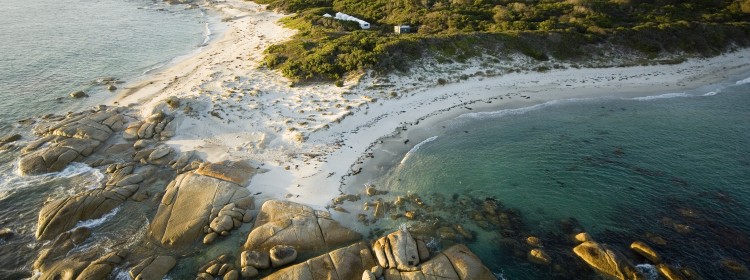By Derryn Heilbuth
We’re heading up the driveway of the 187-year-old Quamby Estate in the lush Tamar Valley. Built by convict Richard Dry who was transported to Tasmania as a political prisoner for his part in the 1804 Irish rebellion, it’s now owned by the Tasmanian Walking Company’s Brett Godfrey and Rob Sherrard (who conceptualised Virgin Australia on the back of a dozen beer coasters in a London pub) and is the starting point for the Bay of Fires walk. It is, as I’ve experienced once before, one of the most rewarding incentive experiences in the Apple Isle.
At the stables of the beautifully manicured estate we meet our two young guides, Louis Balcombe and Harley Tuleja (pictured making tea below). Over the next four days they’ll carry our food, tend to blisters, boil the billy, prepare our meals and share their passion for the coastal heathlands, marsupial lawns and sclerophyll forests of their island home. And all with such larrikin charm that it must surely be one of the requirements of the job.
 “Keep it under eight kilos,” they say as they hand out packs, water bottles and raincoats. As a traveller who likes to pack for every eventuality, it’s a challenge. Having done this walk before, I know I’ll regret that extra jumper thrown in at the last minute. Still, you never know . . .
“Keep it under eight kilos,” they say as they hand out packs, water bottles and raincoats. As a traveller who likes to pack for every eventuality, it’s a challenge. Having done this walk before, I know I’ll regret that extra jumper thrown in at the last minute. Still, you never know . . .
Back on the minibus, our six-strong group are introduced to two other couples (the groups are never larger than 10) and we settle down for the two-and-a-half hour journey to Stumpy’s Bay in the Mount William National Park.
Tasmanian tales
The route takes us across rolling green paddocks and through the old tin towns of Derby and Branxholm, where on the roadside above a few neglected looking weatherboard cottages, we notice a bright red sign.
It marks The Trail of the Tin Dragon, a recently introduced tourist route that’s hoping to reinvigorate this economically depressed and remote northeastern corner of Tasmania by retelling the stories of the 1,500 Chinese miners who battled floods, drought and racial hatred here in the 1870s.
We descend through rainforests of blackwood, sassafras and myrtle until we reach the entrance of the national park. Driving along the sandy track, Louis spots a group of forester kangaroos, the only large ‘roo found in Tasmania. “The first we’ve seen all season”, he says.
At Stumpy’s Bay we disembark, grab our packs, gather for a group picture and then set out on the nine-kilometre hike to the tented cabins where we’ll spend our first night.
In an essay that I will read two days later lying on a sofa in the sun at the Bay of Fires Lodge, academic and author Natasha Cica writes: “As quixotic as its weather, Tasmania is both a place of deliciously warm embrace and cold hard slaps to the face, often in the same day or hour.”
The last time I did this walk we meandered along white sands, swam in turquoise waters, waded chest-high across a creek and sunned ourselves dry on orange lichen-covered rocks. A warm embrace indeed.
Today Tasmania has opted for the cold hard slap. Sand whips our legs as we trudge heads-down into a southerly gale that hurls an angry sea against the granite boulders. It’s tough walking. But raw and elemental too. And since the wind makes it difficult to hear, a perfect time for the meditative state that comes from concentrating on putting one step in front of another.
Refuge for the night
In the late afternoon we reach our refuge for the night: six tented cabins (see top of main picture!) set unobtrusively behind the dunes, a central dining tent and two composting toilets. Water is carried in and waste carried out, so our footprint is light. A big tick for some. A challenge for others more comfortable with five stars. We arrange the blessedly warm sleeping bags and blankets we find neatly folded on the sleeping platforms in the wooden-floored tent, then make our way to the dining tent.
 While Louis and Harley busy themselves preparing the camp’s signature dish of Atlantic salmon on a bed of soba noodle salad and Vietnamese nuoc cham sauce, we sit around the table, tired but contentedly sipping Tasmanian wines and sharing stories with old and new friends.
While Louis and Harley busy themselves preparing the camp’s signature dish of Atlantic salmon on a bed of soba noodle salad and Vietnamese nuoc cham sauce, we sit around the table, tired but contentedly sipping Tasmanian wines and sharing stories with old and new friends.
Nature lessons
The second day’s walk is a solid 14 kilometres. The wind is still our constant companion, but like yesterday, it’s not enough to dampen the enthusiasm of our walking party or take away from our guides’ imaginatively delivered nature lessons.
Alongside an Aboriginal midden they draw time lines in the sand to place the ancient culture in the context of the relatively young Pyramids.
On the coastal heathland they strip a banksia cone to expose the velvety core that served as firelighters for the island’s first people as they moved around this coastline, and crush melaleuca leaves under our noses so we can smell the ti-tree oil they used as an antiseptic.
Back on the beach they pass around a shark egg casing they’ve spotted, lug a massive piece of string kelp across the sand (“they can grow to 30 metres”) and point out the shore birds: gulls, terns and migratory species like the bar-tailed godwits that fly 11,000 kilometres non-stop from the Arctic to their wintering grounds in Australia.
My favourites are the red-beaked hooded plovers that dart in Chaplinesque fashion around the sand foraging for food before returning to their nests on the soft sands above the tideline.
Around lunchtime we reach Tasmania’s most easterly point, Eddystone Point, or Larapuna in the local Aboriginal language. It’s home to a 1889 lighthouse and a collection of keeper’s cottages that are being restored now that the land has been returned to its traditional owners.
From there it’s on to the Bay of Fires proper, stretches of magnificent beaches, so named by Captain Tobias Furneaux, commander of HMS Adventure, the second of Captain Cook’s vessels, after he sighted Aboriginal fires burning on the shore.
 Eco-luxury
Eco-luxury
Last year Lonely Planet named Tasmania one of the top ten regions in the world to visit in 2015. Arriving at the Bay of Fires lodge it’s not hard to see why. A timber and glass eyrie sitting 40 metres above the sea, this is ecotourism at its finest. The multi-award-winning lodge has solar power, rainwater tanks (and timed showers), composting toilets, louvered windows to capture the sea breezes in the simple but comfortable bedrooms, and home-cooked meals designed to show off Tasmanian produce.
As we sit soaking our tired feet in hot foot spas, a glass of wine in hand and the sun setting on a woodland setting of black peppermint and casuarina, all seems well with the world.
The sense of wellbeing stays with us over the next two days. We lounge by the fire and on deckchairs overlooking pristine Abbotsbury beach. We fall asleep in the library; and under the magical hands of Cook Islands born therapist Cecelia Ngavavia at the spa.
On the third day some of our party are too comfortably ensconced to join the kayak adventure. But for those of us who do, the rewards are great. We float serenely down the Anson River. The sunlight plays on the water, a sea eagle flies overhead and my kayaking partner throws a line into the water. On the two-hour walk back to the lodge along the beach the sun comes out and we explore the dunes of the Abbotsbury Peninsula before returning to another evening of good food and wine.
Sparkling finale
The walk ends on the fourth day with a 4.5-kilometre walk through eucalyptus forests, where again Louis and Harley stop to point out the bright green native cherries above us and the delicate coral lichen underfoot. They urge us to spread out so we can experience our surroundings alone and in silence. We eat our picnic lunch and board the bus for the two-hour drive to Andrew Pirie’s Apogee vineyard, 30 kilometres north of Launceston, where we hand in our packs and are treated to a glass of sparkling wine, delicious canapés and a demonstration of how the wine is bottled.
 The first Australian to be awarded a PhD in viticulture, Pirie is a towering figure in the Tasmanian wine industry. Having successfully built the Point Piper and Ninth Island vineyards, he’s now concentrating on producing what he hopes will be the finest sparkling in Australia.
The first Australian to be awarded a PhD in viticulture, Pirie is a towering figure in the Tasmanian wine industry. Having successfully built the Point Piper and Ninth Island vineyards, he’s now concentrating on producing what he hopes will be the finest sparkling in Australia.
All strength to him. It is people like him, the Museum of Old and New Art’s (MONA’s) David Walsh and Tasmanian Walking Company’s Brett Godfrey and Rob Sherrard who are providing the boost the island’s tourist industry needs. It’s an industry worth $2.4 billion a year to the local economy and directly and indirectly employs 28,000 Tasmanians. That’s an important statistic for a state that has a joblessness rate that’s a third greater than the national average and where over a third of its people derive their sole or primary income from a Commonwealth payment.
And if Lonely Planet’s endorsement, or the pristine beaches, or the hospitality of the young lodge hosts and guides, or the exhilarating walk, or the chance to experience one of the most remote and unspoilt places in Tasmania are not enough to persuade, it’s a very good reason to add Tasmania’s Bay of Fires walk to a list of must-do incentive experiences.
From $2,250
The Bay of Fires four-day walk runs from 1 October to 1 May. Prices are quoted on a seasonal basis:
1 October – 24 December $2,250
25 December – 31 March $2,400
1 April – 1 May $2,250
Pricing includes pick up and return from the designated collection and return point, transport to the start of the walk, twin-share accommodation, food and wine, national park passes, use of back pack and Gore-Tex jacket and two qualified guides.
The Siteseer was a paying guest of the Bay of Fires Walk.
Email: bookings@taswalkingco.com.au






